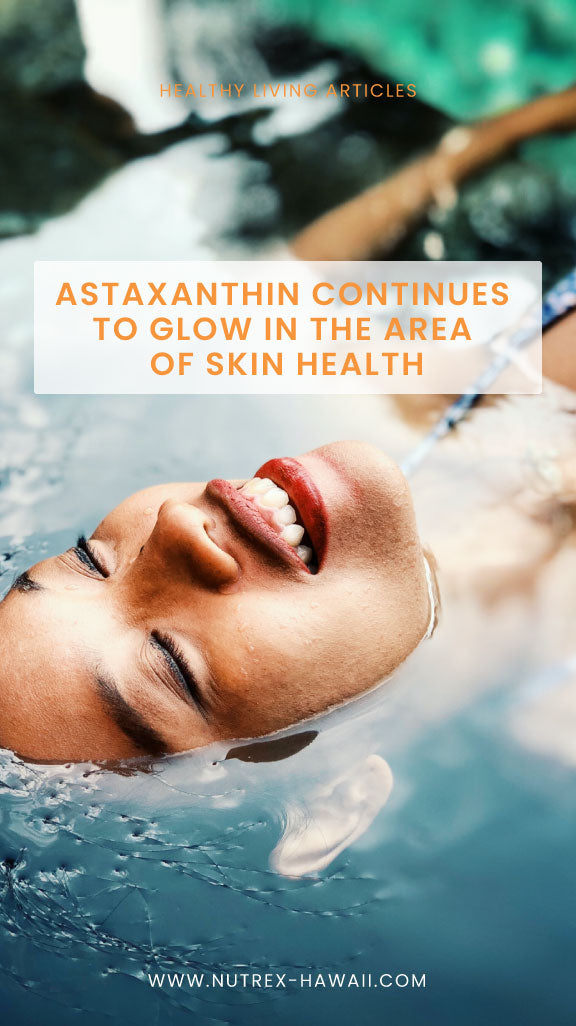Astaxanthin is a powerful antioxidant and carotenoid that is known for its many health benefits, including supporting skin health. The most recent study done on astaxanthin and skin health, “Protective effects of astaxanthin on skin deterioration,” via AstaReal Co. (Tominaga, et al, 2017) continues to support the claim that astaxanthin can support skin health, especially during UV and sun exposure.
Astaxanthin supports the skin during UV and sun exposure*
The 2017 clinical trial was conducted with 59 healthy female participants. The study set out to find the effect of astaxanthin on wrinkles and skin moisture content. The participants were orally given either 6 mg or 12 mg of astaxanthin or a placebo. The participant’s skin was exposed to changing environmental factors over 16 weeks, such as exposure to UV rays. The study found that wrinkles and skin moisture content significantly worsened in the placebo group over the 16 week trial period. But, no significant changes were noticed in the groups that supplemented with astaxanthin. The results of the study suggest that long-term astaxanthin supplementation may “inhibit age-related skin deterioration and maintain skin conditions associated with environmentally induced damage via its anti-inflammatory effect,” (Tominaga, 2017).
This 2017 study echoes a study done in 2001 on astaxanthin protecting the skin from sun exposure. In this study, scientist tested a group of participants to see how much UV light was needed to redden their skin or cause mild sunburn. The participants were give 4 mg of Hawaiian Astaxanthin for two weeks, followed by a skin-reddening test. The results found that 4 mg of astaxanthin per day increased the amount of time it took for UV radiation to redden the skin, demonstrating astaxanthin’s ability to support the structure of the skin during sun exposure (Wood, 2001).
Astaxanthin supports healthy skin*
The two studies mentioned above show that astaxanthin can protect the skin from UV exposure. Other studies have shown other ways that astaxanthin helps support the skin. A landmark 2006 study was conducted with 49 healthy women with an average age of 47 (Yamashita, et al, 2006). Half of the group was given 4 mg of Hawaiian Astaxanthin and the other half was given a placebo. After six weeks, the women were asked to answer questions about their skin quality. Over 50 percent of the women taking astaxanthin reported improvements in skin moisture, content, roughness, fine lines, wrinkles, and elasticity. Dermatologists also examined their skin for these beauty parameters and also found improvements accompanied by changes in skin condition in before-and-after photos.
There were two human studies in 2012 that looked at the effects of astaxanthin on women and men’s skin. The first study was an open-label study that looked at 30 healthy women for eight weeks. Significant improvements were observed by combining 6 mg per day of oral astaxanthin and 2 ml per day of a topical astaxanthin solution. The results from oral and topical application showed improvements in wrinkles, age spot size, elasticity, skin texture, moisture content of the outer most layer of the epidermis (Tominaga, et al, 2012). The other study included 36 healthy men for six weeks that supplemented with 6 mg of astaxanthin per day. The study with men found the same results as the women’s study as far as improvements in skin condition, as well as improvements in the sebum oil level in the cheek zone. Both studies suggest that astaxanthin supplementation may improve the skin condition of both women and men.
Several other studies have used astaxanthin and combined it with other ingredients such as tocotrienols from vitamin E, collagen hydrolysate, and rose hip powder. All studies found positive results on skin condition and health when using astaxanthin combined with other natural ingredients.
These and other studies show lots of promise that astaxanthin could soon be a hot ingredient in the skin and sun care industry. But, you can take advantage of the skin benefits from astaxanthin now by taking BioAstin® Hawaiian Astaxanthin® every day. Think of it as your daily “beauty supplement.”
*These statements have not been evaluated by the Food and Drug Administration. This product is not intended to diagnose, treat, cure, or prevent any disease.
References:
Tominaga, K, et al. (2012). “Cosmetic Benefits of Astaxanthin on Human Subjects.” Acta Biochim Pol, 59(1), 43-47.
Tominaga, K., et al. (2017). “Protective Effects of Astaxanthin on Skin Deterioration.” J. Clin. Biochem. Nutr. Published online: 20 June 2017.
Wood, C., (2001). “Clinical Evaluation of the Potential of an Antioxidant Supplement to Alter Photobiological Responsiveness in Humans.” Consumer Product Testing Co.
Yamashita, E., et al. (2006). “The Effects of a Dietary Supplement Containing Astaxanthin on Skin Condition.” Carotenoid Science, Vol. 10, pp. 91-95.

